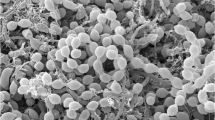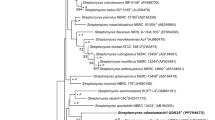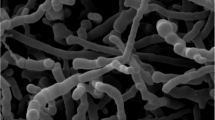Abstract
An actinomycete strain K07-0460T producing new antitrypanosomal antibiotics, spoxazomicins, was isolated from the roots of a variety of orchid collected in the subtropical Okinawa prefecture. The 16S ribosomal RNA gene sequence analysis indicated that the strain belonged to the genus Streptosporangium and showed high similarities with S. amethystogenes subsp. amethystogenes DSM 43179T (99.4%), S. amethystogenes subsp. fukuiense IFO 15365T (99.2%) and S. longisporum DSM 43180T (98.7%). The DNA–DNA hybridization relatedness values between strain K07-0460T and the three strains were below 70%. On the basis of phylogenetic analysis, DNA–DNA hybridization relatedness and physiological characteristics, the strain should be classified as a new species Streptosporangium oxazolinicum sp. nov. in the genus Streptosporangium. The type strain of S. oxazolinicum is K07-0460T (=JCM 17388T).
Similar content being viewed by others
Log in or create a free account to read this content
Gain free access to this article, as well as selected content from this journal and more on nature.com
or
Accession codes
References
Berdy, J. Bioactive microbial metabolites. J. Antibiot. 58, 1–26 (2005).
Lechevalier, H. A. & Lechevalier, M. P. Biology of actinomycetes. Ann. Rev. Microbiol. 21, 71–100 (1967).
Matsumoto, A. et al. Characterization of actinomycetes isolated from fallen leaves. Actinomycetologica 12, 46–48 (1998).
Janso, J. E. & Carter, G. T. Biosynthetic potential of phylogenetically unique endophytic actinomycetes from tropical plants. Appl. Environ. Microbiol. 76, 4377–4386 (2010).
Inahashi, Y., Matsumoto, A., Danbara, H., Ōmura, S. & Takahashi, Y. Phytohabitans suffuscus gen. nov., sp. nov., a novel actinomycete of the family Micromonosporaceae isolated from a plant root. Int. J. Syst. Evol. Microbiol. 60, 2652–2658 (2010).
Indananda, C. et al. Actinophytocola oryzae gen. nov., sp. nov., isolated from the roots of Thai glutinous rice plants, a new member of the family Pseudonocardiaceae. Int. J. Syst. Evol. Microbiol. 60, 1141–1146 (2010).
Inahashi, Y. et al. Spoxazomicins A-C, novel antitrypanosomal alkaloids produced by an endophytic actinomycete, Streptosporangium oxazolinicum K07-0460T. J. Antibiot. (e-pub ahead of print 9 March 2011; doi:10.1038/ja.2011.16) (2011).
Couch, J. N. A new genus and family of the Actinomycetales, with a revision of the genus Actinoplanes. J. Elisha. Mitchell. Sci. Soc. 71, 148–155 (1955).
Nonomura, H. & Ohara, Y. Distribution of the actinomycetes in soil. V. The isolation and classification of the genus Streptosporangium. J. Ferment. Technol. 38, 405–409 (1960).
Schäfer, D. Eine neue Streptosporangium-Art aus türkischer Steppenerde. Arch. Mikrobiol. 66, 365–373 (1969). (In German).
Nonomura, H. & Ohara, Y. Distribution of the actinomycetes in soil. VII. A culture method effective for both preferential isolation and enumeration of Microbispora and Streptosporangium strains in soil. Part 2. Classification of the isolates. J. Ferment. Technol. 47, 701–709 (1969).
Kawamoto, I. et al. new antibiotic victomycin (XK 49-1-B-2). I. Taxonomy and production of the producing organism. J. Antibiot. 28, 358–365 (1975).
Shearer, M. C., Colman, P. M. & Nash III, C. H. Streptosporangium fragile sp. nov. Int. J. Syst. Bacteriol. 33, 364–368 (1983).
Mertz, F. P. & Yao, R. C. Streptosporangium carneum sp. nov. isolated from soil. Int. J. Syst. Bacteriol. 40, 247–253 (1990).
Iinuma, S., Yokota, A. & Kanamura, T. New subspecies of the genus Streptosporangium, Streptosporangium amethystogenes subsp. fukuiense subsp. nov. Actinomycetologica 10, 35–42 (1996).
Petrolini, B., Quaroni, S., Sardi, P., Saracchi, M. & Andriollo, N. A sporangiate actinomycete with unusual morphological features: Streptosporangium claviforme sp. nov. Actinomycetes 3, 45–50 (1992).
Zhang, L., Jiang, C. & Chen, W. Streptosporangium subroseum sp. nov., an actinomycete with an unusual phospholipid pattern. Int. J. Syst. Evol. Microbiol. 52, 1235–1238 (2002).
Zhang, L.- P., Jiang, C.- L. & Chen, W.- X. Streptosporangium yunnanense sp. nov. and Streptosporangium purpuratum sp. nov., from soil in China. Int. J. Syst. Evol. Microbiol. 55, 719–724 (2005).
Zhang, L.- P., Zhang, L.- M. & Zhang, X.- M. Streptosporangium canum sp. nov., isolated from soil. Int. J. Syst. Evol. Microbiol. 59, 1715–1719 (2009).
Shirling, E. B. & Gottlieb, D. Methods for characterization of Streptomyces species. Int. J. Syst. Bacteriol. 16, 313–340 (1966).
Waksman, S. A. (ed.). in: The Actinomycetes Vol. 2 (Williams and Wilkins Co., Baltimore, 1961).
Jacobson, E., Grauville, W. C. & Fogs, C. E. Color Harmony Manual, 4th edn (Container Corporation of America, Chicago, 1958).
Pridham, T. G. & Gottlieb, D. The utilization of carbon compounds by some Actinomycetales as an aid for species determination. J. Bacteriol. 56, 107–114 (1948).
Hayakawa, M. & Nonomura, H. Humic acid-vitamin agar, a new medium for selective isolation of soil actinomycetes. J. Ferment. Technol. 65, 501–509 (1987).
Gordon, R. E., Barnett, D. A., Handerhan, J. E. & Pang, C. H. N. Nocardia coeliaca, Nocardia autotrophica and the nocardin strain. Int. J. Syst. Bacteriol. 24, 54–63 (1974).
Collins, M. D., Pirouz, T., Goodfellow, M. & Minnikin, D. E. Distribution of menaquinones in actinomycetes and corynebacteria. J. Gen. Microbiol. 100, 221–230 (1977).
Tamaoka, J., Katayama-Fujimura, Y. & Kuraishi, H. Analysis of bacterial menaquinone mixtures by high performance liquid chromatography. J. Appl. Bacteriol. 54, 31–36 (1983).
Becker, B., Lechevalier, M. P. & Lechevalier, H. A. Chemical composition of cell-wall preparation from strains of various form-genera of aerobic actinomycetes. Appl. Microbiol. 13, 236–243 (1965).
Uchida, K. & Aida, K. Acyl type of bacterial cell wall: its simple identification by a colorimetric method. J. Gen. Appl. Microbiol. 23, 249–260 (1977).
Minnikin, D. E., Patel, P. V., Alshamaony, L. & Goodfellow, M. Polar lipid composition in the classification of Nocardia and related bacteria. Int. J. Syst. Bacteriol. 27, 104–117 (1977).
Tomiyasu, I. Mycolic acid composition and thermally adaptative changes in Nocardia asteroides. J. Bacteriol. 151, 828–837 (1982).
Saito, H. & Miura, K. Preparation of transforming deoxyribonucleic acid by phenol treatment. Biochim. Biophys. Acta. 72, 619–629 (1963).
Tamaoka, J. & Komagata, K. Determination of DNA base composition by reversed-phase high-performance liquid chromatography. FEMS Microbiol. Lett. 25, 125–128 (1984).
Ezaki, T., Hashimoto, Y. & Yabuuchi, E. Fluorometric deoxyribonucleic acid-deoxyribonucleic acid hybridization in microdilution wells as an alternative to membrane filter hybridization in which radioisotopes are used to determine genetic relatedness among bacterial strains. Int. J. Syst. Bacteriol. 39, 224–229 (1989).
Kimura, M. A simple method for estimating evolutionary rates of base substitutions through comparative studies of nucleotide sequences. J. Mol. Evol. 16, 111–120 (1980).
Gouy, M., Guindon, S. & Gascuel, O. SeaView version 4: a multiplatform graphical user interface for sequence alignment and phylogenetic tree building. Mol. Biol. Evol. 27, 221–224 (2010).
Saitou, N. & Nei, M. The neighbor-joining method: a new method for reconstructing phylogenetic trees. Mol. Biol. Evol. 4, 406–425 (1987).
Felsenstein, J. Evolutionary trees from DNA sequences: a maximum likelihood approach. J. Mol. Evol. 17, 368–379 (1981).
Kluge, A. G. & Farris, F. S. Quantitative phyletics and the evolution of anurans. Syst. Zool. 18, 1–32 (1969).
Felsenstein, J. Confidence limits on phylogenies: an approach using the bootstrap. Evolution 39, 783–791 (1985).
Chun, J. et al. EzTaxon: a web-based tool for the identification of prokaryotes based on 16S ribosomal RNA gene sequences. Int. J. Syst. Evol. Microbiol. 57, 2259–2261 (2007).
Lechevalier, M. P., De Bièvre, C. & Lechevalier, H. A. Chemotaxonomy of aerobic actinomycetes: phospholipids composition. Biochem. Syst. Ecol. 5, 249–260 (1977).
Wayne, L. G. et al. International Committee on Systematic Bacteriology. Report of the Ad Hoc Committee on reconciliation of approaches to bacterial systematics. Int. J. Syst. Bacteriol. 37, 463–464 (1987).
Acknowledgements
This work was financially supported in part by a research grant from the Institute for Fermentation, Osaka (IFO), Japan. We thank Professor Jean P Euzeby (Society for Systematic and Veterinary Bacteriology) for his help with the nomenclature.
Author information
Authors and Affiliations
Corresponding author
Rights and permissions
About this article
Cite this article
Inahashi, Y., Matsumoto, A., Ōmura, S. et al. Streptosporangium oxazolinicum sp. nov., a novel endophytic actinomycete producing new antitrypanosomal antibiotics, spoxazomicins. J Antibiot 64, 297–302 (2011). https://doi.org/10.1038/ja.2011.18
Received:
Revised:
Accepted:
Published:
Issue date:
DOI: https://doi.org/10.1038/ja.2011.18
Keywords
This article is cited by
-
Uncovering the biodiversity and biosynthetic potentials of rare actinomycetes
Future Journal of Pharmaceutical Sciences (2022)
-
Streptosporangium minutum sp. nov., isolated from garden soil exposed to microwave radiation
The Journal of Antibiotics (2018)
-
Endophytic actinomycetes: promising source of novel bioactive compounds
The Journal of Antibiotics (2017)
-
Streptosporangium terrae sp. nov., a novel actinomycete isolated from the rhizosphere of Callistemon citrinus (Curtis), India
The Journal of Antibiotics (2015)
-
Continuing hunt for endophytic actinomycetes as a source of novel biologically active metabolites
World Journal of Microbiology and Biotechnology (2015)



